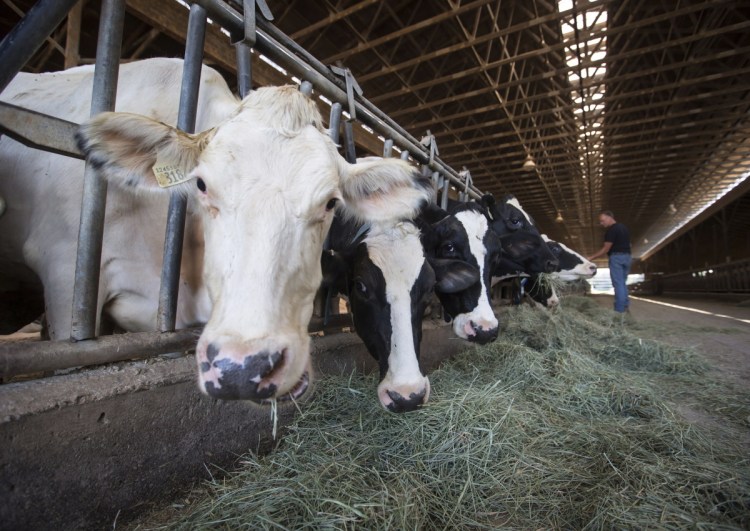Republican leaders in Congress have made it clear they aren’t keen to approve President Trump’s attempt to update the North American Free Trade Agreement unless he can get both Mexico and Canada on board.
And because Congress gets the final thumbs-up or thumbs-down on the trade deal, Trump really needs some help from our neighbor to the north. Canadian Foreign Minister Chrystia Freeland is in town this week for meetings with top U.S. trade officials, but the two sides remain split on some major issues – and they go beyond Trump’s testy history with Canadian Prime Minister Justin Trudeau.
Here are three key issues holding up Trump’s attempt to cut a three-way deal.
DAIRY
“There’s a word Canada has trouble with. It’s M-I-L-K,” Larry Kudlow, Trump’s top economic adviser, said Tuesday on Fox and Friends. Canada keeps milk prices high by using supply management, a system that restricts how much milk is sold in Canada and how much foreign milk can enter the country. Canada has done this for 50 years, and it’s popular in some parts of the country because Canadian dairy farmers enjoy high and steady incomes. But it has prevented U.S. producers from selling much milk or cheese to Canada, since any dairy products that aren’t part of the supply-management quota are socked with high tariffs of 200 to 300 percent.
On the flip side, Canada accuses the United States of granting massive subsidies to dairy. One study claims that 73 percent of U.S. dairy-farmer returns come from support programs, whereas U.S. producers argue they get insurance payments from the government mainly when prices are low.
Canada has struck a compromise with other trading partners, including Europe, to allow foreign producers to have a bigger share of sales in Canada. That could work for the NAFTA update, trade experts say, but Trump is fixated on getting the tariffs down. Dairy was excluded from the original NAFTA deal that removed tariffs on most other items moving across the border.
DISPUTE RESOLUTION
Known as “Chapter 19,” this original NAFTA provision allows one country to challenge another over tariffs or dumping cheap goods below market value. It’s basically a fast-track version of going to the World Trade Organization and complaining about unfair trading practices. Instead of waiting years for a WTO case or a U.S. court case, a NAFTA Chapter 19 board decides quickly.
The United States would love to rip that chapter out, but Canada wants to save it. Two sources familiar with the trade deliberations said this is the thorniest issue. The Canadian government has been using Chapter 19 to go after the Trump administration, and Trudeau has wide support across the aisle in his country to keep Chapter 19 intact. But Trump wants greater ability to use protectionist measures when he thinks U.S. workers and firms are being harmed.
This issue goes hand-in-hand with Chapter 11, known as investor-state dispute settlement. Chapter 11 gives companies a mechanism to sue foreign governments for changing rules on them and hurting their profits. The U.S. and Mexico struck a compromise on this: It will still apply in full to some industries – especially energy, where companies are worried that the new Mexican government might tear up their government drilling contracts – but it will be lessened for other industries. It’s unclear what Canada will do on Chapter 11; Trudeau and his team have spoken far more fervently about protecting Chapter 19.
TARIFFS
The bad blood over trade really started when Trump put tariffs on Canadian steel and aluminum, arguing that Canadian metals are a “national security threat” to the United States. Trump used a law know as Section 232 that has rarely been used since NAFTA was created. Trudeau blasted the 232 tariffs as “insulting” and nonsensical, citing the two countries’ longtime alliance and generally balanced trade.
Canada wants the steel and aluminum tariffs removed if a new NAFTA deal passes. Even more important, the Canadians don’t want Trump turning around in a few months and hitting Canada with tariffs on cars, a massive industry for the Canadians. So far, the Trump administration is hesitant to agree. A senior White House official said the 232 negotiations are “on their own track separate from NAFTA.”
Trump wants options to hit harder later on, and his administration has argued that the United States should have a right to protect itself, but many trade experts find it hard to justify that bringing SUVs in from Canada poses a national security threat.
Other issues: climate change, intellectual property, and more. Canada wants better environmental protections and the United States wants better intellectual property protections. They are likely to compromise along the lines of what is in the Trans Pacific Partnership and what was agreed to with Mexico.
There’s also the “sunset clause.” The White House claims this deal will last for 16 years, but there is an option to “review” the deal after just six years. Originally the U.S. side wanted a five-year sunset of the deal, meaning it would have to be formally renegotiated every five years.
Send questions/comments to the editors.


